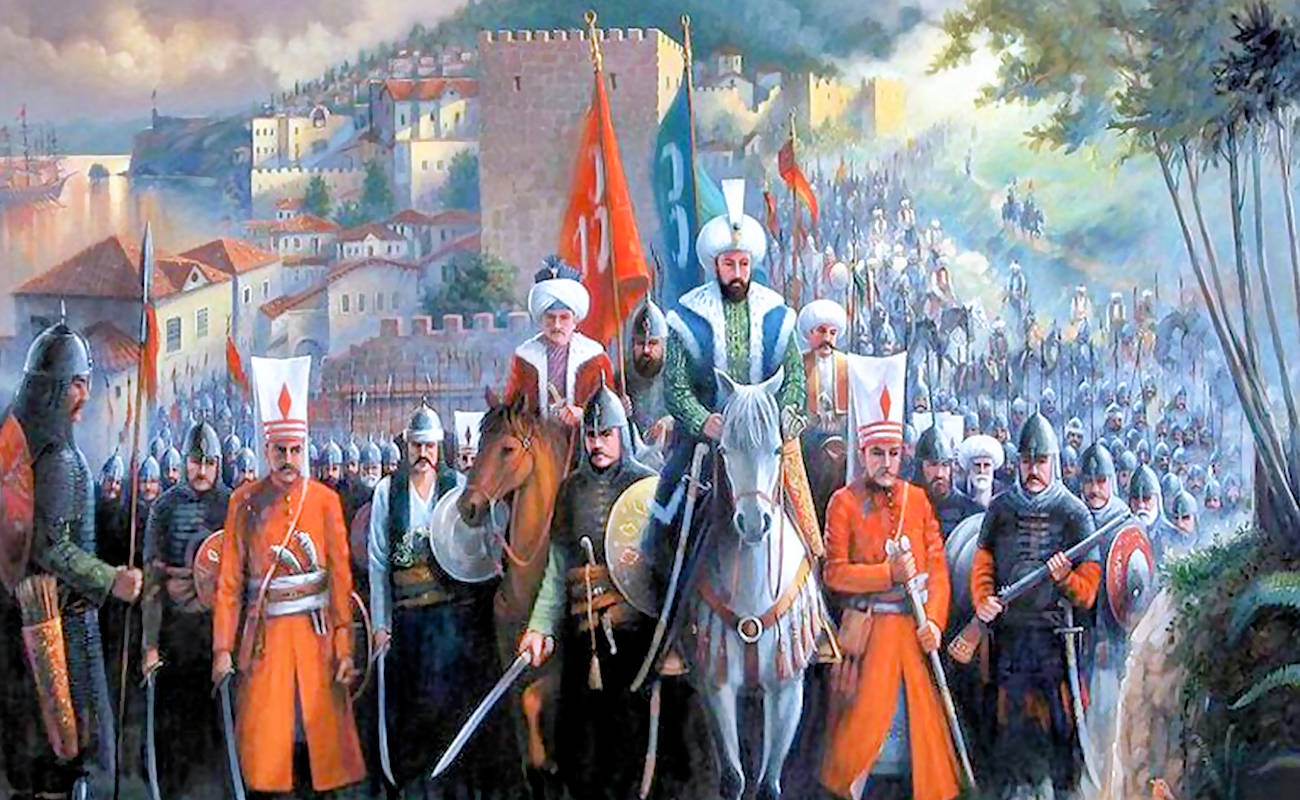
Fatih Sultan Mehmed – the Father of Conquest
Fatih Sultan Mehmed (the Father of Conquest) was an Ottoman sultan who reigned twice, from 1444 to 1446 and from 1451 to 1481. He was born on March 30, 1432, in Adrianople, Thrace, Ottoman Empire. He passed away on May 3, 1481, at Hunkârçayırı, near Maltepe, close to Constantinople. Under his command, Constantinople was captured and territories in Anatolia and the Balkans were conquered, which constituted the heartland of the Ottoman Empire for the next four centuries.
Fatih Sultan Mehmed (the Father of Conquest) was the fourth son of Murad II and Hümâ Hâtûn, who was enslaved and in the harem of Murad II. At 12 years old, he followed tradition and went to Manisa (Magnesia) with his two tutors. The same year, his father settled him on the throne at Edirne before abdicating. In his first reign (August 1444-May 1446), Mehmed faced severe external and internal crises, with Hungary’s king, the pope, the Byzantine Empire, and Venice all seeking to exploit the fact that a young child had become the Ottoman ruler and succeeding in forming a Crusade.
Edirne witnessed a fierce conflict between Candarlı Halil, a prominent grand vizier, and the rival viziers Zaganos and Şihâbeddin, who claimed to defend the child sultan’s rights. The Crusaders’ army had crossed Danube in September 1444. Hearing this, Edirne saw an upsurge in violence that resulted in the massacre of the Christian- influenced Ḥurūfī sect and caused widespread arson and panic. When Varna was besieged by the Crusaders, the father of the then ruling sultan was implored to abandon his retirement in Bursa and lead the army.
The Ottoman Empire‘s triumph at Varna under Murad II on November 10, 1444 marked the resolution of the crises. Mehmed II, who stayed in Edirne, maintained his seat on the throne, while his father retired to Manisa following the battle. Zaganos and Şihâbeddin encouraged the young sultan to capture Constantinople, but Çandarlı incited the Janissaries to revolt and called Murad II back to Edirne to resume the throne (May 1446). Mehmed was then sent back to Manisa with Zaganos and Şihâbeddin, who were newly appointed as his tutors. He continued to see himself as the legitimate sultan during this time.
Upon the death of his father, Fatih Sultan Mehmed (the Father of Conquest) took the throne in Edirne for a second time on February 18, 1451. His main objective was to capture Constantinople, although it did not cause much concern in Europe and Byzantium, who remembered his previous reign. Additionally, his authority was not yet solidified throughout the empire. However, Mehmed swiftly established his dominance by severely punishing the Janissaries who had threatened him due to the customary gift of accession being delayed.
He strengthened the military organization, which he intended to use for future conquests. He meticulously planned the required diplomatic and military preparations for capturing Constantinople. To maintain Venice and Hungary’s neutrality, he signed treaties advantageous to them. In 1452, he devoted most of his time to constructing the fortress of Boğazkesen (later Rumeli Hisarı) to control the Bosporus Strait, building a fleet of 31 galleys, and casting new, large-calibre cannons.
The renowned Hungarian master gunsmith, Urban, was commissioned to cast cannons of a size hitherto unknown in Europe. During the siege of Constantinople (April 6–May 29, 1453), opposing views were expressed in two war councils at crucial points. Çandarlı, the grand vizier, argued against the enterprise. Zaganos vehemently rejected the proposal to lift the siege and instead prepared for the final assault. On the day of the attack, the commander in chief, Mehmed II, himself directed the operations against the breach created in the city’s wall by his cannon.
The day following the city’s capture, Çandarlı was arrested and subsequently executed in Edirne. Zaganos, who had become Mehmed’s father-in-law, replaced him. Mehmed had agreed to a three-day plundering of the city but retracted his order before the evening of the first day. He entered the city at the forefront of a procession and immediately converted Hagia Sophia into a mosque. Following his leadership, charitable foundations were established, and 14,000 gold ducats per annum were provided for the upkeep and service of the mosque.
One of Fatih Sultan Mehmed’s (the Father of Conquest) goals was to restore the city, now commonly known as Istanbul, as a suitable capital for his empire. To promote the return of the Greeks and Genoese who fled from Galata (the trading district of the city), he restored their homes and ensured their safety. To repopulate the city, he relocated groups of Muslims and Christians from Anatolia and the Balkans and compelled them to settle in Constantinople.
On January 6, 1454, he restored the Greek Orthodox Patriarchate and appointed a Jewish grand rabbi and an Armenian Apostolic (Orthodox) patriarch in the city. Furthermore, he initiated and encouraged his viziers to initiate numerous Muslim institutions and commercial installations in the main districts of Constantinople. These nuclei served as the foundation for the rapid development of the metropolis. Based on a 1478 survey, there were 16,324 households and 3,927 shops in Constantinople and nearby Galata. After fifty years, Constantinople had grown to be the largest city in Europe.
Fatih Sultan Mehmed’s Empire
Fatih Sultan Mehmed’s (the Father of Conquest) Empire gained immeasurable glory, prestige and immense authority in his country after the capture of Constantinople. He began to view himself as the heir of the Roman Caesars and the champion of Islam in holy war. Although it is false that he had predetermined intentions for his conquests, it is certain that he aimed to revive the Eastern Roman Empire and expand it to its fullest historical extent. Mehmed’s triumph over Uzun Ḥasan, the Turkmen leader, at the Battle of Bashkent in Erzincan on August 11, 1473, was a defining moment in his reign, akin in significance to his conquest of Constantinople. This military conquest secured his domination over the Balkans and Anatolia.
Mehmed had taken on the title of Kayser-i Rum (Roman Caesar) while also referring to himself as “the lord of the two lands and the two seas” which represented his vision for the empire, encompassing both Anatolia and the Balkans, as well as the Aegean and Black Seas. In the twenty-five years following the collapse of Constantinople, he launched several campaigns and expeditions across the Balkans, Hungary, Wallachia, Moldavia, Anatolia, the island of Rhodes, and even as far as the Crimean Peninsula and Otranto in southern Italy.
The 1480 expedition revealed his plans to invade Italy as a fresh attempt at establishing a world empire. Subsequently, during the following spring and at the commencement of another Anatolian campaign, he passed away 15.5 miles (25 km) from Constantinople.
The autocrat was afflicted with gout in his final days, causing him great suffering. However, possible indications suggest that he may have been poisoned.
In the latter years of his reign, he experienced tension with his eldest son, Bayezid due to his disobedience. Fatih Sultan Mehmed’s (the Father of Conquest) financial policies incited significant disapproval across the country during his reign’s final years, particularly when he granted around 20,000 villages and farms that belonged to pious foundations or landed gentry as military fiefs. Hence, critics selected Bayezid as the new ruler upon Mehmed’s passing, sidelining his preferred son Cem (Jem), and launching an opposition against his policies.
Achievements
The conqueror reorganized the Ottoman government, codifying criminal law and laws relating to subjects in one code. Another code was elaborated for the constitution, and the two codes formed the nucleus of all subsequent legislation. From the utterly autocratic personality of the conqueror emerged the classical image of an Ottoman padishah (emperor). He was extremely severe towards those who opposed his decrees and laws, and even his Ottoman peers deemed him excessively harsh.
However, Mehmed can be deemed as the most open-minded and free-thinking of all Ottoman sultans. After the fall of Constantinople, he brought together Italian humanists and Greek scholars at his court. He commissioned Patriarch Gennadius II Scholarios to write a Christian faith credo and had it translated into Turkish. Additionally, he amassed a library of Greek and Latin literature in his palace. He enlisted Gentile Bellini from Venice to embellish his palace walls with frescoes and to paint his portrait, which is now on display in the National Gallery in London.
Around the grand mosque he built, he erected eight colleges that maintained their position for almost a century as the primary institutions for teaching Islamic sciences in the empire. Periodically, he gathered the ʿulamāʾ, or knowledgeable Muslim scholars, and directed them to deliberate on theological problems in his presence. During his reign, mathematics, astronomy, and Muslim theology attained their pinnacle among the Ottomans. And Mehmed also left a “divan,” which is a compilation of poems in the classical style of Ottoman literature.
